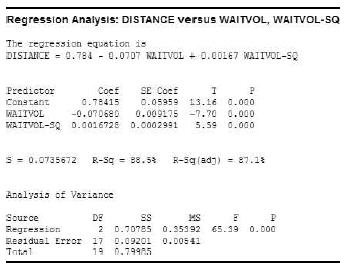Refer to the Journal of Transportation Engineering (June 2013) study of overcrowding at a train station, Exercise
Question:
Refer to the Journal of Transportation Engineering (June 2013) study of overcrowding at a train station, Exercise 12.14. Using data collected for a sample of 20 train stops (see below), you analyzed the quadratic model, E(y) = β0 + β1x1 + β2x2, where y = average distance (meters) between passengers and x = volume of passengers waiting (number of persons) on the train platform.

a. Find the correlation between x and x2. What potential problems may occur due to this correlation? Do you recommend coding the independent variable, x?
b. Give the equation relating the coded variable u for volume( x), using the coding system for observational data.
c. Find the correlation between u and u2. Has the multicollinearity problem been diminished?
d. Fit the model, E(y) = β0 + β1u1 + β2u2 using available statistical software. Interpret the results.
Data from Exercise 12.14
The level of overcrowding for passengers waiting at a train station was investigated in the Journal of Transportation Engineering (June 2013). The researchers measured “crowdedness” as the average distance between the forefront edge of the passenger waiting on a platform and the rear edge of the one in front of this passenger. This variable reflects the degree of closeness of passengers waiting in line for the next train. The shorter the distance, the more crowded the platform. The average distance (y, in meters) was hypothesized to be related to the volume of passengers waiting (x, number of persons) on the train platform. Data (simulated from information provided in the journal article) on these two variables for a sample of 20 train stops are listed in the accompanying table. Consider the quadratic model, E(y) = β0 + β1x1 + β2x2. A Minitab printout of the regression analysis follows. In theory, the rate of decrease of distance with increasing passenger volume should level off for more crowded platforms. Use the model to test this theory at β = .01.

Step by Step Answer:

Statistics For Engineering And The Sciences
ISBN: 9781498728850
6th Edition
Authors: William M. Mendenhall, Terry L. Sincich





